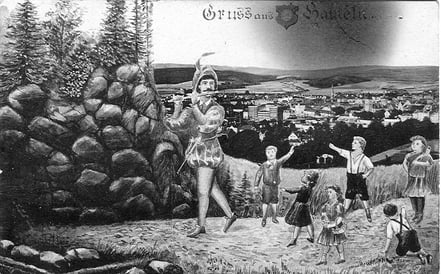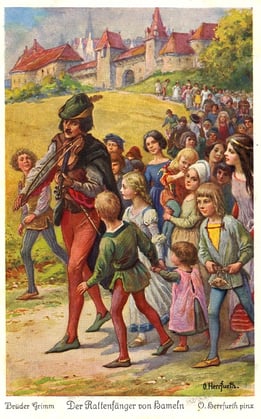Deep within the children’s section of the local library, is an old dusty copy of classic fairytales. Behind the faded cover lives stories of heroism, nobility, and true love; stories that eagerly fill the minds of young dreamers everywhere. However, dwelling amongst the “once upon a times” and “happily ever afters” is a far more sinister tale of rat infestation, broken promises, and the disappearance of an entire city’s children.
 The Pied Piper legend originated in Hamelin, Germany during the middle ages. As the story goes, the town was struggling with a rat infestation problem and was desperate for relief. A mysterious man in “pied clothing” approached the mayor and promised he could rid the city of its problem in return for payment of 1000 guilders. They mayor agreed, and the man played a magical pipe to lure all the city’s rats to a nearby body of water, where they drowned. When the Piper returned for his reward, the mayor refused.
The Pied Piper legend originated in Hamelin, Germany during the middle ages. As the story goes, the town was struggling with a rat infestation problem and was desperate for relief. A mysterious man in “pied clothing” approached the mayor and promised he could rid the city of its problem in return for payment of 1000 guilders. They mayor agreed, and the man played a magical pipe to lure all the city’s rats to a nearby body of water, where they drowned. When the Piper returned for his reward, the mayor refused.
As if visualizing a rat infestation was not traumatizing enough, the story then takes another sinister turn. Furious that he had been cheated, the piper soon returned to the town of Hamelin on St. John and Paul’s day. As the grown members of the town attend church, the Piper once again played his magical pipe through the streets, this time luring the town’s 130 children from their homes. Depending on the version of the story, he either led them to the lake or into a cave, and none were ever seen again. Most versions agree there were a few children left behind—one was crippled and he could not keep up, one was deaf so he could not hear the music, and one was blind and could not see where the other children were going. When church let out, the survivors told the towns people what had happened, and the rest is history.
If presenting the pied piper as a bedtime tale to someone you love, I would highly recommend editing the ending to something along the lines of “The mayor graciously paid the piper for his service, and the rodent-free town of Hamelin lived happily ever after.” However, if you would like to take on a more investigative lens, there are several interesting theories about what really happened that fateful day.
 While no theorist addresses my personal burning question of “why did the children left behind choose to wait until after church was over to report the mass kidnapping?”, there are several different angles from which to translate such a dreary tale. One such perspective is that the phrase “children of Hamelin” was not meant to convey literal youths, but rather “inhabitants of the town,” and that following the Pied Piper was actually a metaphor for emigrating. Another angle identifies the Pied Piper as a personification of death, and the children who go with him are those who died from the plague brought to the town by the rat infestation. A third brutal possibility is that the children actually left to join a military campaign, but never returned.
While no theorist addresses my personal burning question of “why did the children left behind choose to wait until after church was over to report the mass kidnapping?”, there are several different angles from which to translate such a dreary tale. One such perspective is that the phrase “children of Hamelin” was not meant to convey literal youths, but rather “inhabitants of the town,” and that following the Pied Piper was actually a metaphor for emigrating. Another angle identifies the Pied Piper as a personification of death, and the children who go with him are those who died from the plague brought to the town by the rat infestation. A third brutal possibility is that the children actually left to join a military campaign, but never returned.
Although we may never know the true events that fueled such a story, there are still lessons to be learned from this mysterious account. Keep your promises, avoid rats, and always exercise caution around mysterious pipers.









